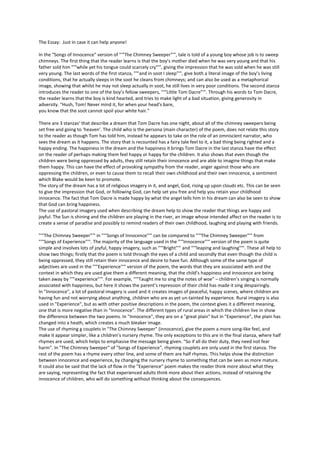
SONGS ONF INNOCENCE and SONGS OF EXP help 4 essay
- 1. The Essay: Just in case it can help anyone! In the “Songs of Innocence" version of "'"The Chimney Sweeper"'", tale is told of a young boy whose job is to sweep chimneys. The first thing that the reader learns is that the boy’s mother died when he was very young and that his father sold him "'"while yet his tongue could scarcely cry"'", giving the impression that he was sold when he was still very young. The last words of the first stanza, "'"and in soot I sleep"'", give both a literal image of the boy’s living conditions, that he actually sleeps in the soot he cleans from chimneys; and can also be used as a metaphorical image, showing that whilst he may not sleep actually in soot, he still lives in very poor conditions. The second stanza introduces the reader to one of the boy’s fellow sweepers, "'"Little Tom Dacre"'". Through his words to Tom Dacre, the reader learns that the boy is kind hearted, and tries to make light of a bad situation, giving generosity in adversity. "Hush, Tom! Never mind it, for when your head's bare, you know that the soot cannot spoil your white hair." There are 3 stanzas’ that describe a dream that Tom Dacre has one night, about all of the chimney sweepers being set free and going to ‘heaven’. The child who is the persona (main character) of the poem, does not relate this story to the reader as though Tom has told him, instead he appears to take on the role of an omniscient narrator, who sees the dream as it happens. The story that is recounted has a fairy tale feel to it, a bad thing being righted and a happy ending. The happiness in the dream and the happiness it brings Tom Dacre in the last stanza have the effect on the reader of perhaps making them feel happy or happy for the children. It also shows that even though the children were being oppressed by adults, they still retain their innocence and are able to imagine things that make them happy. This can have the effect of provoking sympathy from the reader, anger against those who are oppressing the children, or even to cause them to recall their own childhood and their own innocence, a sentiment which Blake would be keen to promote. The story of the dream has a lot of religious imagery in it, and angel, God, rising up upon clouds etc. This can be seen to give the impression that God, or following God, can help set you free and help you retain your childhood innocence. The fact that Tom Dacre is made happy by what the angel tells him in his dream can also be seen to show that God can bring happiness. The use of pastoral imagery used when describing the dream help to show the reader that things are happy and joyful. The Sun is shining and the children are playing in the river, an image whose intended affect on the reader is to create a sense of paradise and possibly to remind readers of their own childhood, laughing and playing with friends. "'"The Chimney Sweeper"'" in "'"Songs of Innocence"'" can be compared to "'"The Chimney Sweeper"'" from "'"Songs of Experience"'". The majority of the language used in the "'"Innocence"'" version of the poem is quite simple and involves lots of joyful, happy imagery, such as "'"Bright"'" and "'"leaping and laughing"'". These all help to show two things; firstly that the poem is told through the eyes of a child and secondly that even though the child is being oppressed, they still retain their innocence and desire to have fun. Although some of the same type of adjectives are used in the "'"Experience"'" version of the poem, the words that they are associated with and the context in which they are used give them a different meaning, that the child’s happiness and innocence are being taken away by "'"experience"'". For example, "'"Taught me to sing the notes of woe" – children’s singing is normally associated with happiness, but here it shows the parent’s repression of their child has made it sing despairingly. In "Innocence", a lot of pastoral imagery is used and it creates images of peaceful, happy scenes, where children are having fun and not worrying about anything, children who are as yet un-tainted by experience. Rural imagery is also used in "Experience", but as with other positive descriptions in the poem, the context gives it a different meaning, one that is more negative than in “Innocence". The different types of rural areas in which the children live in show the difference between the two poems. In "Innocence", they are on a "great plain" but in "Experience", the plain has changed into a heath, which creates a much bleaker image. The use of rhyming g couplets in "The Chimney Sweeper" (innocence), give the poem a more song-like feel, and make it appear simpler, like a children’s nursery rhyme. The only exceptions to this are in the final stanza, where half rhymes are used, which helps to emphasise the message being given. "So if all do their duty, they need not fear harm". In "The Chimney Sweeper" of "Songs of Experience", rhyming couplets are only used in the first stanza. The rest of the poem has a rhyme every other line, and some of them are half rhymes. This helps show the distinction between innocence and experience, by changing the nursery rhyme to something that can be seen as more mature. It could also be said that the lack of flow in the "Experience" poem makes the reader think more about what they are saying, representing the fact that experienced adults think more about their actions, instead of retaining the innocence of children, who will do something without thinking about the consequences.
